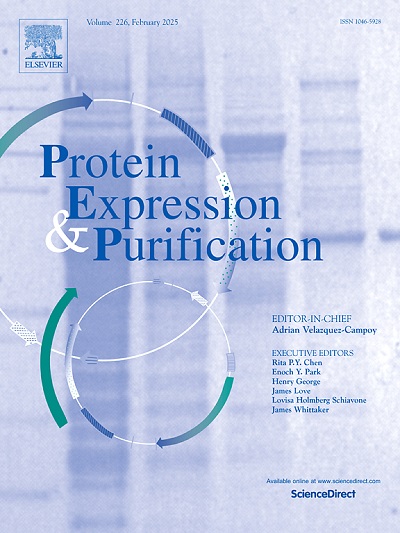High-affinity nanobodies targeting IL-12B for the detection of fluorescence resonance energy transfer
IF 1.2
4区 生物学
Q4 BIOCHEMICAL RESEARCH METHODS
引用次数: 0
Abstract
Aims
IL-12B, a subunit of the IL-23 family of cytokines, plays a crucial role in various diseases such as viral infections, autoimmune disorders, and tumors. This study aimed to identify high-affinity nanobodies that bind to distinct epitopes of IL-12B to and assess their potential for therapeutic and diagnostic applications, particularly through fluorescence resonance energy transfer(FRET) to evaluate their ability to target IL-12B.
Methods
IL-12B protein was expressed in eukaryotic cells and used to immunize camels to induce an immune response. Camel-derived anti-IL-12B nanobodies were isolated and screened via phage display to identify those with high specificity and affinity for IL-12B. Binding affinity and epitope interactions were further analyzed using high-performance liquid chromatography (HPLC) and ForteBio Octet assays. A FRET-based assay was developed to evaluate protein interactions for precise therapeutic targeting.
Results
Several high-affinity nanobodies targeting IL-12B were successfully generated. These nanobodies exhibited strong binding to various epitopes of IL-12B. Screening by HPLC and ForteBio Octet confirmed their high specificity and affinity, while fluorescence analysis demonstrated efficient energy transfer between thenanobodies, indicating successful interactions.
Conclusions
This study identified high-affinity nanobodies against IL-12B and used FRET to characterize their interactions. These nanobodies show promise for therapeutic potential targeting IL-12B-related diseases, including viral infections, autoimmune disorders, and cancer. However, further clinical studies are needed to fully explore their potential for diagnostic and therapeutic applications.

靶向IL-12B的高亲和纳米体用于荧光共振能量转移检测。
目的:IL-12B是IL-23细胞因子家族的一个亚基,在病毒感染、自身免疫性疾病、肿瘤等多种疾病中发挥重要作用。本研究旨在鉴定与IL-12B不同表位结合的高亲和力纳米体,并评估其治疗和诊断应用的潜力,特别是通过荧光共振能量转移(FRET)来评估其靶向IL-12B的能力。方法:在真核细胞中表达IL-12B蛋白,用免疫法诱导骆驼免疫应答。利用噬菌体展示技术对骆驼源性抗IL-12B纳米体进行筛选,鉴定出对IL-12B具有高特异性和亲和力的纳米体。利用高效液相色谱(HPLC)和ForteBio Octet检测进一步分析结合亲和力和表位相互作用。开发了一种基于fret的检测方法来评估蛋白质相互作用,以实现精确的治疗靶向。结果:成功生成了多个靶向IL-12B的高亲和力纳米体。这些纳米体显示出与IL-12B的各种表位的强结合。高效液相色谱和ForteBio Octet筛选证实了它们的高特异性和亲和力,而荧光分析显示纳米体之间有效的能量传递,表明相互作用成功。结论:本研究确定了针对IL-12B的高亲和力纳米体,并利用FRET表征了它们的相互作用。这些纳米体显示出治疗il - 12b相关疾病的潜力,包括病毒感染、自身免疫性疾病和癌症。然而,需要进一步的临床研究来充分挖掘其诊断和治疗应用的潜力。
本文章由计算机程序翻译,如有差异,请以英文原文为准。
求助全文
约1分钟内获得全文
求助全文
来源期刊

Protein expression and purification
生物-生化研究方法
CiteScore
3.70
自引率
6.20%
发文量
120
审稿时长
32 days
期刊介绍:
Protein Expression and Purification is an international journal providing a forum for the dissemination of new information on protein expression, extraction, purification, characterization, and/or applications using conventional biochemical and/or modern molecular biological approaches and methods, which are of broad interest to the field. The journal does not typically publish repetitive examples of protein expression and purification involving standard, well-established, methods. However, exceptions might include studies on important and/or difficult to express and/or purify proteins and/or studies that include extensive protein characterization, which provide new, previously unpublished information.
 求助内容:
求助内容: 应助结果提醒方式:
应助结果提醒方式:


